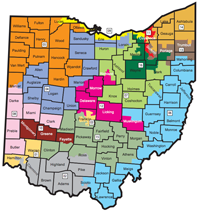Featured Work

Gerrymandering: A Look at Ohio
Ohio Congressional Districts Map, Ohio Secretary of State Democracy fails to work when its people are not represented fairly and equally. But when one looks at the Ohio Congressional Map (full size) through the lens of two colors—red for Republicans and blue for Democrats—the complicated lines make sense. The red and blue map is a classic example of gerrymandering—the manipulation of district boundaries that favors one party over another, often splitting communities apart. Following the 2010 U.S. Census, Republicans controlled the process of redrawing the lines. Republicans gave themselves 12 districts and packed the Democrats into four districts. Before 2000, the control was split between both Democrats and Republicans, leading to a fairer and more equal distribution of seats and votes. However, after 2000, Republicans gained control and redrew the lines to keep returning their majority delegations to Columbus and Washington. In the last two elections, Republicans got 75 percent of the congressional seats in Ohio, with just 55 percent of the vote. Used with permission, WikiMedia Commons It’s important to acknowledge that this issue is not about Republicans or Democrats, but about doing what’s best for the civil liberties of Ohioans. A possible solution to the gerrymandering state legislature districts is the Ohio Bipartisan Redistricting Commission Amendment (OBRCA) 2015, now known as the Fair Districts for Ohio ballot initiative. The resolution passed both state legislatures with bipartisan support and will appear on the November 3, 2015 ballot as Issue 1. If approved by voters, it will set Ohio on a path to fairer statewide elections. Giving the Minority Party a Voice Currently, the five-member Apportionment Board is responsible for redrawing the state legislative lines. The state board is made up of the governor, auditor, secretary of state, a member from the majority party, and a member from the minority party. If one party controls all branches of government, then the voice of the minority is sidelined. This is evident in the 2000 and 2010 redistricting process, as Republicans controlled all three branches of government in Ohio. Provided Issue 1 passes, the Apportionment Board will be replaced with the Ohio Redistricting Commission (ORC), which would consist of seven members: the governor, auditor, secretary of state, and four members appointed by the majority and minority leaders in the General Assembly. In order for any redistricting plan to pass, four members would have to vote in favor, including at least one Democrat and one Republican. In other words, a redistricting plan cannot be passed without the voice of both parties being represented. More Competitive Elections The hallmark of our democracy is a robust discussion about the issues and challenges that face our communities. Under the current system, Ohioans are voting for the party more so than the person running for office. The current lines have led to the emergence of “safe seats” where the nominee from one party or the other is all but guaranteed election.

The Economic Impact of Immigration: A Look at Ohio
In America, 11 million undocumented immigrants are living on the outskirts of society. Of those 11 million, 95,000 live in Ohio. Many of these immigrant have been in the United States for more than 10 years and they have been waiting for a legal pathway to citizenship. On November 20, 2014, they got some good news. President Obama announced a series of executive actions to fix the nation’s broken immigration system. The executive actions included the expansion of the Deferred Action for Childhood Arrivals program and the introduction of a new program for parents called Deferred Action for Parents of Americans and Lawful Permanent Residents.

